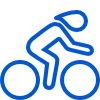Overtaking and Filtering Whilst Cycling
Many drivers in the UK, particularly those living in busy cities, will have at some point felt a pang of jealousy towards the cyclists on the road who are able to ride though the traffic to their destination. However, whilst the ability to ride past stationary traffic is one of the many benefits of choosing to cycle, many road users are unsure of whether or not it is technically legal or, for that matter, safe.
In the context of cycling, ‘filtering’ means moving past slow or stationary traffic, either on the left or the right of the traffic ahead. Whilst neither the law, nor the Highway Code definitively state whether or not filtering by cyclists is legal, it can be inferred from the text of the Highway Code that it is acceptable practice, for example:
Rule 160 states that road users should ‘be aware of other road users, especially cycles and motorcycles who may be filtering through the traffic’ and Rule 88, in relation to manoeuvring, states that road users should take care and keep speed low ‘…when filtering in slow-moving traffic’. Furthermore, rule 211 says that ‘it is often difficult to see motorcyclists and cyclists, especially when they are filtering through traffic’.
Although Rule 211 states that drivers should ‘look out for cyclists or motorcyclists on the inside of the traffic’ which could be taken to mean that drivers have responsibility for looking for riders before performing a manoeuvre, it is important for cyclists to anticipate the actions of other road users and avoid risks at all times. There is no specific guidance in the Highway Code about when it is or is not safe to filter through traffic, however there are some basic pieces of safety advice that cyclists should have in mind when on the roads.
Perhaps the most important advice for cyclists contemplating filtering through traffic is to avoid doing so on the approach to a junction. This advice is echoed in Rule 167 of the Highway Code: ‘Do not overtake where you might come into conflict with other road users. For example, approaching or at a road junction on either side of the road’. Obviously the risk of doing so is that a car ahead may turn into a side road without warning, leaving the cyclist with inadequate time to brake or change direction.
It is also important to note that it is far more dangerous to filter on the left hand side of a vehicle, or ‘undertake’, than it is to filter on the right hand side, or ‘overtake’, this is the case even where there is a designated cycle lane on the left of the road. This is particularly true where the vehicle in front is a long vehicle, such as a bus or lorry, because cyclists on the left of such vehicles are likely to be in the driver’s blind spot. Being in a driver’s blind spot not only leaves the cyclist at a higher risk of the vehicle turning without warning, but also leaves them at risk even if the vehicle makes a slight movement to the left of the lane. Such situations could have fatal consequences for the cyclist as they will have no space between the vehicle and the kerb to manoeuvre. Filtering on the left hand side should only be done when the traffic is completely stationary and the cyclist is confident that it will remain so until they are safely past the vehicle.
Once the traffic is moving again cyclists should slot back into the stream of traffic without braking or changing direction suddenly. In order to do this it is recommended that when filtering through traffic cyclists do not go excessively fast as a good deal of foresight will be needed with regard to the rest of the traffic.
Advanced stop lines have been introduced on many roads in the UK. These are areas that are reserved for cyclists at junctions and they allow cyclists to start off first when the traffic starts moving. Often cyclists will need to filter through stopped traffic in order to reach the advanced stop lines, however, it will sometimes be better practice to wait behind other cars at a junction than to squeeze through a precarious space next to the kerb in order to reach the cyclists area. Cyclists should keep in mind that undertaking on the left is dangerous even where vehicles are stationary or where there is a cycle lane on the road.
There is very little case law that deals with situations where cyclists have been injured whilst overtaking or filtering, however, some guidance can be taken from similar situations involving motorcycles. Cases such as Pell v Moseley (2003) and Hillman v Tomkins (1995), both of which concerned a motorcyclist involved in a collision whilst overtaking on the right, demonstrate that the outcome of such cases depends on the particular facts of each case; this is likely to be the case in situations involving bicycles as well. In both of these cases the judge found that the rider and driver were equally to blame, because, they both should have anticipated the actions of the other. Whether or not a driver or rider is to blame for any accident whilst filtering seems to depend on factors such as the speed of the vehicles and the bicycle, the parties’ knowledge of the local area and the location of the accident, e.g., was it near a junction? Although it is legal to filter on a bicycle, it can be inferred from the motorcyclist cases that where cyclists are found to have been filtering in a way deemed to be ‘bad practice’ when a collision takes place, there is strong chance of a finding of contributory negligence on the part of the cyclist.
Where there is a finding of split liability, the driver will only have to pay a percentage of the damages, which will correspond with their percentage of the liability for the accident. The cyclist may also be awarded their legal costs for bringing the case, but that is always at the discretion of the judge.
Clearly there are dangers surrounding the practice of filtering by cyclists and there is as yet little guidance from the courts as to what is expected of cyclists in this regard. What does seem reasonably certain is that in the event of a collision, the success of a claim for damages would depend on the manner in which each party was driving or riding. Where a cyclist was riding in an unsafe manner it is likely that they will be held at least partly responsible for the accident, despite the Highway Code placing a duty on drivers to look out for riders who may be filtering through traffic. It would be highly beneficial for some definitive legal and practical guidance to be produced in this area because as it stands, the uncertainty surrounding the practice of filtering only causes confusion.
Sources
Cycle Scheme – Road Positioning

Cycle Compensation
Our specialist lawyers have recovered millions of pounds on behalf of injured claimants and will guide you through your cycle claim.

Cycle Repairs
Recovering the full cost of getting your bike repaired or replaced, so you can get back on the road as soon as possible.

Rehabilitation
To alleviate pain, help you return to work or get back on your bike. We will help you make the best recovery possible.
